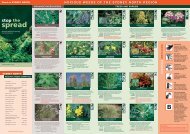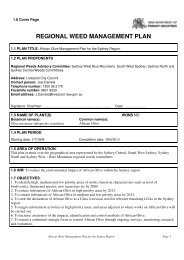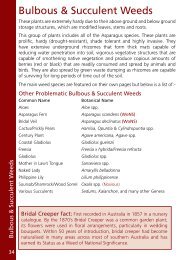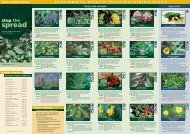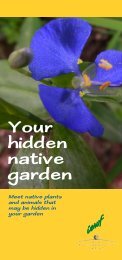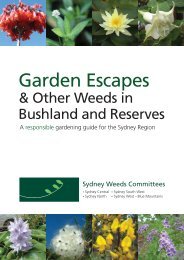SPREAD - Sydney Weeds Committees
SPREAD - Sydney Weeds Committees
SPREAD - Sydney Weeds Committees
Create successful ePaper yourself
Turn your PDF publications into a flip-book with our unique Google optimized e-Paper software.
<strong>Weeds</strong> of <strong>Sydney</strong> West<br />
stop<br />
the<br />
<strong>SPREAD</strong><br />
Noxious and Environmental <strong>Weeds</strong><br />
are Spoiling our Environment<br />
www.sydneyweeds.org.au<br />
SYDNEY WEST – BLUE MOUNTAINS<br />
REGIONAL WEEDS COMMITTEE<br />
Auburn City Council........................................................................9735 1222<br />
Blue Mountains City Council ..........................................................4780 5000<br />
Department of Defence ..................................................................4587 1929<br />
Dept of Environment and Conservation - National Parks & Wildlife<br />
• Cumberland Area North region (Windsor area) ............4572 3100<br />
• Blue Mountains Region .................................................4784 7308<br />
Dept of Infrastructure, Planning and Natural Resources ...............9895 6211<br />
Department of Lands (Crown land)................................................9228 6666<br />
Department of Primary Industries (<strong>Sydney</strong> region)........................4588 2100<br />
Forests NSW .............................................................................1300 655 687<br />
Hawkesbury River County Council (HRCC)...................................4577 5573<br />
HRCC controls noxious weeds in:<br />
• Baulkham Hills Shire Council........................................9843 0555<br />
• Blacktown City Council..................................................9839 6000<br />
• Hawkesbury City Council ..............................................4560 4444<br />
• Penrith City Council.......................................................4732 7777<br />
Hawkesbury Nepean Catchment Management Authority ..............4828 6747<br />
Holroyd City Council.......................................................................9840 9840<br />
Parramatta City Council .................................................................9806 5000<br />
Penrith Lakes Development Corporation .......................................4729 0044<br />
Railcorp ..............................................................................................131 500<br />
Roads and Traffic Authority ................................................................131 700<br />
<strong>Sydney</strong> Catchment Authority..........................................................4725 2100<br />
<strong>Sydney</strong> Water.....................................................................................132 092<br />
<strong>Sydney</strong> Metropolitan Catchment Management Authority...............9895 7536<br />
Upper Parramatta River Catchment Trust......................................9891 4633<br />
www.sydneyweeds.org.au<br />
BROAD LEAF<br />
PRIVET<br />
Botanical Name: Ligustrum lucidum (broad)<br />
Ligustrum sinense (small)<br />
Very common tree (4 to 10 m) and tall shrub (up to 3m)<br />
found in moist areas in gullies and home gardens. Broad<br />
leaf sp. has large dark green leaves arranged opposite on<br />
the stem, paler underside. Small leaf sp. has small narrow,<br />
wavy leaves. Native to China.<br />
Flowers/Fruit: Small, white, strongly scented flowers. Sprays of purple<br />
black berries occurring in winter.<br />
Dispersal: Birds and water.<br />
Declared Noxious: Blue Mountains, Parramatta and Hawkesbury River County<br />
Councils. (Holroyd and Auburn Councils are seeking declaration in their areas.)<br />
BITOU BUSH/BONESEED<br />
Weed of National Significance<br />
Botanical Name: Chrysanthemoides monilifera<br />
Shrub to 2m. There are two forms: a thick coastal dune<br />
variety with rounded leaves (subspecies rotundata), and<br />
an upright plant with coarsely toothed leaves (subsp.<br />
monilifera). Native to S. Africa.<br />
Flowers/Fruit: Golden yellow, daisy flowers appearing mostly in spring to<br />
early summer. Clusters of purple black berries.<br />
Dispersal: Birds<br />
Declared Noxious: Parramatta, Blue Mountains, Auburn and Holroyd Councils.<br />
RHUS<br />
Botanical Name: Toxicodendron succedaneum<br />
A shrub/small deciduous tree to 4m. Compound leaves,<br />
turning brilliant red in autumn. Native to China, Japan<br />
and Himalayas.<br />
Flowers/Fruit: Very small, creamy white, flowers in spring. Clusters<br />
of pale brown berries (5 to 7mm) turning papery on<br />
ripening.<br />
Dispersal: Birds<br />
Declared Noxious: All <strong>Sydney</strong> West and Blue Mountains Councils.<br />
Special Note: This plant can cause severe dermatitis and swelling of the<br />
face if any part of the plant makes skin contact (the sap causing the most<br />
severe reaction).<br />
CAPE BROOM<br />
SMALL LEAF<br />
Botanical Name: Genista monspessulana<br />
Flowers/Fruit: A woody shrub, with many branches and growing to 3m<br />
tall. Small leaves and numerous yellow pea flowers.<br />
Flowers are in clusters and show up in Spring and<br />
Summer. Hard, black shiny seeds. Small hairy brown<br />
seed pod. Native to the Mediterranean.<br />
Dispersal: Water, animals and mud on shoes or tyres.<br />
Declared Noxious: Blue Mountains and Parramatta Councils.<br />
W E E D S O F T H E S Y D N E Y W E S T R E G I O N<br />
AFRICAN BOXTHORN GREEN CESTRUM<br />
LANTANA<br />
RHIZOMATOUS BAMBOO<br />
Botanical Name: Lycium ferocissimum<br />
Thorny, large shrub to 5m with lots of branches.<br />
Native to S. Africa.<br />
Flowers/Fruit: Purplish-white flowers with darker purple blotches in<br />
centre, flowering mainly in spring and summer but<br />
sporadically throughout the year. Fleshy bright orangered<br />
round berries.<br />
Dispersal: Birds, animals and dumping. It suckers from root<br />
fragments if disturbed.<br />
Declared Noxious: Hawkesbury River County and Blue Mountains Councils.<br />
© Geoff Sainty<br />
BLACK WILLOW<br />
Weed of National Significance<br />
Botanical Name: Salix nigra<br />
Deciduous rapidly-growing tree to about 20m tall with 1-4<br />
trunks. Non-drooping, shiny and red-brown twigs when<br />
exposed to sun, thin leaves and deeply fissured grey bark.<br />
Native to N. America.<br />
Flowers/Fruit: Trees either male or female. Flower spikes (catkins)<br />
appear with leaves in spring. Male catkins yellow, female<br />
catkins green.<br />
Dispersal: Seeds spread by water and new trees can sprout from<br />
broken branches. Major weed of streams and river banks.<br />
Declared Noxious: Blue Mountains Council.<br />
CASTOR OIL PLANT<br />
Botanical Name: Ricinus communis<br />
Tall shrub to 3m high common in waste areas. The<br />
stems are red tinged and the leaves are large, with<br />
suppressed veins. White sap. Native to Africa.<br />
Flowers/Fruit: Reddish green, flowers in summer. Green to black<br />
spiny fruit capsule occuring in autumn.<br />
Dispersal: Seed explosion from capsule, water.<br />
Declared Noxious: Parramatta, Auburn and Holroyd Councils.<br />
Special Note: Seeds are highly toxic to humans and animals.<br />
OCHNA, MICKEY MOUSE PLANT<br />
Botanical Name: Ochna serrulata<br />
Hardy shrub to 2m high grown commonly as<br />
garden hedge. Shiny, fine toothed and wavy leaves.<br />
Removal is made difficult due to the extended taproot.<br />
Native to South Africa.<br />
Flowers/Fruit: Yellow flowers in spring. Crown of black berries<br />
surrounded by red “petals” occurring in autumn.<br />
Dispersal: Birds and dumping of garden clippings.<br />
Declared: Environmental Weed<br />
TREES AND SHRUBS<br />
Botanical Name: Cestrum parqui<br />
Woody shrub 2-3m tall with light green alternate leaves<br />
to 12cm long, giving off an unpleasant smell when<br />
crushed. Native to S. America.<br />
Flowers/Fruit: Sprays of small tubular yellow-green flowers on end<br />
of stems from late spring to autumn.Shiny black egg<br />
shaped berries in clusters.<br />
Dispersal: Birds and water.<br />
Declared Noxious: All <strong>Sydney</strong> West and Blue Mountains Councils.<br />
Special Note: Highly poisonous to livestock, and toxic to humans.<br />
AFRICAN OLIVE<br />
Botanical Name: Olea europaea subsp. africana<br />
Small evergreen tree 2-15m high, often grown as a<br />
garden ornamental and as a hedge. Narrow, dark green<br />
lance-shaped leaves, younger leaves have tiny brown<br />
scales on the underside. Native to South Africa.<br />
Flowers/Fruit: White to cream tubular flowers, flowering in spring at<br />
the junction of the leaves and the stem. Green berries in<br />
winter ripening to purple-black. Produces thousands of<br />
seeds.<br />
Dispersal: Foxes and birds.<br />
Declared: Environmental Weed<br />
BLACKBERRY<br />
Weed of National Significance<br />
Botanical Name: Rubus fruticosus<br />
Shrub with scrambling stems generally 2 to 3m high.<br />
The arching stems are green to reddish purple and<br />
covered in prickles. The leaves are in groups of 3<br />
to 5, are dark green and often shed in winter.<br />
Native to Europe.<br />
Flowers/Fruit:: White or pink, flowers in spring to summer. Black,<br />
aggregated berry occuring in late summer.<br />
Dispersal: Birds, foxes, re-rooting stems, dumping.<br />
Declared Noxious: All <strong>Sydney</strong> West and Blue Mountains Councils.<br />
COOTAMUNDRA WATTLE<br />
Botanical Name: Acacia baileyana<br />
Flowers/Fruit: A woody shrub growing to 6-10m – fine and silver-grey<br />
foliage. Flowers are small, soft golden balls.<br />
Dispersal: Birds<br />
Declared : Environmental Weed<br />
Special Note: This is an Australian native plant, that has become invasive<br />
in areas outside of its original region. Cootamundra Wattle is a threat<br />
to an enadangered species, Downy Wattle (Acacia pubescens) through<br />
interbreeding and cross pollination.<br />
Weed of National Significance<br />
Botanical Name: Lantana camara<br />
Fast growing shrub with brittle scrambling branches,<br />
square stems with short prickles and opposite hairy<br />
leaves with distinctive smell. Native to S. America.<br />
Flowers/Fruit: Small clusters of red, pink or yellow flowers all year.<br />
Black berries, fruiting most heavily in summer.<br />
Dispersal: Birds, dumping, branches re-rooting at ground level.<br />
Declared Noxious: All <strong>Sydney</strong> West and Blue Mountains Councils.<br />
Special Note: Large stands have sometimes been found to provide habitat<br />
for native animals.<br />
HONEY LOCUST<br />
Botanical Name: Gleditsia triacanthos<br />
A long-lived fast growing deciduous tree which can<br />
quickly form dense thickets. Large thorns grow from<br />
the trunk and branches. Native to N. America.<br />
Flowers/Fruit: Creamy yellow hanging flower stalks to 10cm long<br />
are borne in October-November. These are followed<br />
by brown flattened seed pods to 20-40cm long.<br />
Dispersal: Animals and water. Suckering roots.<br />
Declared: Environmental Weed.<br />
Special Note: The large thorns can injure humans and animals.<br />
Caution: Always wear goggles and protective equipment when treating.<br />
PAMPAS GRASS<br />
Botanical Name: Cortaderia selloana<br />
Large long-lived tussock over 2m high with numerous<br />
fluffy seedheads and sharp, cutting leaves. Native to<br />
S. America.<br />
Flowers/Fruit: Pale flowers in summer. Each plume produces up to<br />
100,000 seeds in late summer/autumn.<br />
Dispersal: Waterways and wind dispersal.<br />
Declared Noxious: All <strong>Sydney</strong> West and Blue Mountains Councils<br />
Special Note: Smaller clumps can be dug out. Dry clumps are highly<br />
flammable and provide habitat for snakes and feral pests.<br />
CASSIA<br />
Botanical Name: Senna pendula<br />
Flowers/Fruit: Small tree up to 5m tall. Its leaves are in 3-5 pairs of<br />
oval dark green leaflets that are opposite each other<br />
on the stem. Flowers are bright yellow clusters on the<br />
ends of the branches.<br />
Dispersal: Birds<br />
Declared : Environmental Weed<br />
Special Note: Can be confused with the native Breynia<br />
(Breynia oblongifolia).<br />
Botanical Name: Phyllostachys spp.<br />
Woody plant to 6m high with underground runners<br />
(rhizomes). Cultivated as ornamentals, they may<br />
become weeds in gardens, bushland and wasteland.<br />
Native to Asia.<br />
Flowers/Fruit: Rarely appear (at intervals of over 100 years).<br />
Dispersal: Produces erect shoots from rhizomes forming loosely<br />
clumped shoots over large areas, dumping.<br />
Declared Noxious: Parramatta and Blue Mountains Councils.<br />
CONTROL METHODS<br />
SUCCULENT<br />
MOTHER OF MILLIONS<br />
Botanical Name: Bryophyllum delagoense<br />
Slender erect succulent perennial with pinkish brown<br />
or greyish stems up to 60cm high with thick waxy<br />
leaves. Native to Madagascar.<br />
Flowers/Fruit: Tubular red to orange flowers from May to October.<br />
Form drooping clusters at the top of long stalks.<br />
Dispersal: Many minute plantlets on the circumference of<br />
each leaf are able to form a new plant when the<br />
leaves break off. Forms fast spreading colonies.<br />
Noxious Weed: Hawkesbury River County Council.<br />
Special Note: Highly toxic to stock.<br />
Noxious Weed<br />
Physical removal<br />
Necessary for plants which regrow from<br />
bulbs, tubers, roots or other plant parts<br />
eg. runners.<br />
Cut and paint<br />
Suited to woody plants (shrubs, small<br />
trees) and vines. Cut the trunk or vine<br />
stem horizontally and as low as possible,<br />
then apply glyphosate herbicide immediately.<br />
Stem-scraping<br />
Scrape one side of the stem to expose the<br />
growing layer. Immediately apply glyphosate<br />
to the scrape.<br />
Low volume spraying only<br />
Suitable for weeds that are less than 1<br />
metre in height. Spray with a herbicide that<br />
is registered for that weed. Do not spray<br />
woody weeds, shrubs or vines over 1 metre<br />
in height. (Note: for high volume spraying go to<br />
www.environment.nsw.gov.au/pesticides for<br />
information about the NSW Pesticides Act and<br />
Regulation, legal requirements for training and<br />
record keeping.)<br />
Frilling<br />
Suited to trees. Horizontal cuts are made<br />
around the trunk and glyphosate applied<br />
immediately.<br />
Biological control<br />
Biocontrol agents are available for this weed.<br />
Biocontrol is important, but is also expensive<br />
and needs to be co-ordinated closely to<br />
ensure that maximum success is obtained<br />
in establishing the agent and controlling the<br />
weed. Biocontrol is not appropriate for use<br />
on individual properties.<br />
For more information, contact your local council.
WHAT IS A WEED?<br />
A weed is any plant out of place. <strong>Weeds</strong> take over a<br />
natural area by smothering the ground, blocking light and<br />
suppressing the growth of new native seedlings of grasses,<br />
groundcovers, shrubs and trees. Over time, the habitat<br />
for native wildlife is reduced, the normal bushfire patterns<br />
are altered, and the whole character and ecosystem of the<br />
bush changes.<br />
NOXIOUS WEEDS<br />
A noxious weed is one that legally must be controlled<br />
or removed under the Noxious <strong>Weeds</strong> Act. <strong>Weeds</strong> are<br />
declared noxious if they pose a significant problem to<br />
human health, the environment, livestock or the agriculture<br />
industry. In NSW, local Councils are responsible for<br />
controlling weeds in urban and rural areas under their<br />
responsibility. A Council can enforce penalities on<br />
landholders failing to control weeds on their property.<br />
ENVIRONMENTAL WEEDS<br />
In the <strong>Sydney</strong> West – Blue Mountains region, waterways<br />
and remaining areas of natural bushland are under<br />
threat due to the invasion of environmental weeds.<br />
These ‘introduced’ plants have few predators and usually<br />
produce vast quantities of seed, and so easily out-compete<br />
or smother native plants. This makes them vigourous<br />
invaders, especially in disturbed areas and where soil<br />
nutrient levels are high, such as stormwater channels.<br />
GARDEN ESCAPES<br />
<strong>Weeds</strong> usually begin life in someone’s backyard. Common<br />
garden plants can be spread through birds eating the seed<br />
or people dumping garden clippings into the bush.<br />
WHAT YOU CAN DO<br />
1. For a comprehensive list of weeds declared<br />
noxious in your area, contact your local Council<br />
or visit: www.dpi.nsw.gov.au/weeds<br />
2. Remove any weeds identified in this brochure.<br />
There are bush regeneration contractors working<br />
in your area that may be able to assist with weed<br />
control.<br />
3. Never dump garden waste in bushland areas.<br />
4. Compost garden clippings on-site or place in<br />
Council green-waste bins for collection.<br />
5. Replace unwanted plants with locally indigenous<br />
native species.<br />
6. Join or start a Volunteer Bush Regeneration<br />
(Bushcare) Group through your local Council.<br />
<strong>Sydney</strong> West –<br />
Blue Mountains Regional<br />
<strong>Weeds</strong> Committee<br />
The committee is made up of land managers from<br />
local Councils and statutory authorities within the<br />
<strong>Sydney</strong> West – Blue Mountains region.<br />
The aims of the committee are to:<br />
• promote the co-ordination of noxious and<br />
environmental weed management at the<br />
regional and catchment levels;<br />
• provide a forum for information exchange<br />
between member organisations;<br />
• increase awareness of noxious and<br />
envrionmental weeds in the broader<br />
community; and<br />
• identify new problem weed species.<br />
<strong>Weeds</strong> of the<br />
Blue Mountains region<br />
There are many weeds that are more<br />
commonly found in areas of high altitudes.<br />
Phone Blue Mountains City Council on<br />
4780 5000 for a free copy of the booklet<br />
<strong>Weeds</strong> of Blue Mountains Bushland.<br />
www.weedsbluemountains.org.au<br />
NEED MORE INFORMATION?<br />
• Visit these websites:<br />
www.dpi.nsw.gov.au/weeds<br />
www.sydneyweeds.org.au<br />
www.weeds.org.au<br />
ACKNOWLEDGEMENTS FOR PHOTOS:<br />
Sutherland Shire Council, Luke McLachlan, Jo Lynch, Colin G. Wilson,<br />
Peter Cuneo, Paul Marynissen, Ku-ring-gai Council, Parsons & Cuthbertson<br />
(Noxious <strong>Weeds</strong> of Australia Book), Adam Burrowes, Lorna Rose, Barbara<br />
Harley, Geoff Sainty, Rosanna Luca and Department of Primary Industries.<br />
Control logos courtesy of Lismore City Council.<br />
Brochure design and layout by POD Graphics.<br />
Edits and front cover design by Olive Graphic Design.<br />
Botanical Name: Anredera cordifolia<br />
Fleshy, green perennial climber (up to 40m). Leaves<br />
are succulent and rounded. Located in fertile soils,<br />
disturbed sites and wastelands. Native to S. America.<br />
Flowers/Fruit: Greenish-cream-white “lamb’s tail” sprays occurring<br />
in autumn. Reproduction is mainly vegetative by the<br />
growth of aerial tubers along succulent stems. Also<br />
has underground tubers that survive after disturbance.<br />
This weed has recently started to seed in some parts<br />
of Australia.<br />
Dispersal: Dumping. Aerial tubers fallen to the ground after<br />
disturbance will take root and generate new plants.<br />
Declared Noxious: Parramatta Council.<br />
CLIMBERS/SCRAMBLERS<br />
BALLOON VINE MORNING GLORY<br />
Botanical Name: Cardiospermum grandiflorum<br />
Vigorous climber growing as high as can be supported.<br />
Has the ability to kill native plants by smothering,<br />
blocking out sunlight. Common in wet areas especially<br />
along creeks. Native to Asia, Africa and America<br />
Flowers/Fruit: White flowers, occurring in mid-summer. Pale green<br />
balloon-like papery capsule enclosing 3 black seeds.<br />
Seeds are produced in autumn.<br />
Dispersal: By wind (whilst still attached to papery capsule) and<br />
water along creeklines.<br />
Declared Noxious: Parramatta Council.<br />
MADEIRA VINE<br />
ALLIGATOR WEED<br />
Weed of National Significance<br />
CONTACT<br />
YOUR<br />
LOCAL<br />
COUNCIL<br />
Botanical Name: Alternanthera philoxeroides<br />
Terrestrial or aquatic (floating or rooted) herb found<br />
in slow moving and still water forming mats of<br />
interwoven roots and stems. Native to S. America.<br />
Flowers/Fruit: Silvery white flowers in late summer.<br />
Seeds produced but rarely viable under Australian<br />
conditions. Reproduction is entirely vegetative.<br />
Dispersal: Water flow dumping and machinery. Thick underlying<br />
mats of old stems can seriously impair water flow.<br />
Declared Noxious: All <strong>Sydney</strong> West and Blue Mountains Councils.<br />
If you find this weed, notify your local council<br />
immediately.<br />
Special Note: Contact your local council for advice on control and correct<br />
disposal. The fleshy tap roots are brittle and hard to control. Similar<br />
species is the native Lesser joyweed (Alternanthera denticulata).<br />
Botanical Name: Ipomoea indica<br />
A vigorous, twining, herbaceous perennial climber with<br />
heart-shaped leaves and hairy stems. Has the ability to<br />
smother trees and understorey vegetation. Common in<br />
moist, disturbed places. Native to Tropical Regions.<br />
Flowers/Fruit: Distinct violet-blue flowers 5 to 8cm in diameter<br />
occurring anytime in the year, particularly in warm<br />
months. Does not set seed in Australia.<br />
Dispersal: Dumping of stem fragments.<br />
Declared Noxious: Parramatta Council.<br />
Weed of National Significance<br />
JAPANESE HONEY SUCKLE<br />
Botanical Name: Parietaria judaica<br />
A brittle perennial herb to 60cm high commonly<br />
found in rock crevices and walls. The stem (reddish<br />
coloured) and leaves have fine hairs allowing the<br />
plant to stick to clothing. Native to Europe.<br />
Flowers/Fruit: Very small greenish flowers all year. Dark brownblack<br />
seed enclosed in a small nut, occurring<br />
prolifically in spring and autumn.<br />
Dispersal: Wind, water, local re-rooting.<br />
Declared: Environmental Weed.<br />
Special Note: Pollen can cause serious allergic reactions such as<br />
rhinitis, asthma and conjunctivitis. Always use gloves and mask when<br />
removing by hand.<br />
BRIDAL CREEPER<br />
Weed of National Significance<br />
MOTH VINE<br />
ASPARAGUS FERN<br />
Botanical Name: Asparagus asparagoides<br />
Dense scrambler or climber up to 3m long with<br />
alternate shining green leaves, turning yellow and<br />
dying back in summer. Underground mat of rhizomes<br />
that bear numerous fleshy tubers. Native to S. Africa.<br />
Flowers/Fruit: Solitary white flowers in August-September. Each petal<br />
has a distinctive central green stripe. Green pea-sized<br />
berries, turning pink then burgundy.<br />
Dispersal: Birds, water and dumping and rhinzome growth.<br />
Declared Noxious: Parramatta Council<br />
Special Note: May be confused with the native species Wombat Berry<br />
(Eustrephus latifolius).<br />
CONTACT<br />
YOUR<br />
LOCAL<br />
COUNCIL<br />
Botanical Name: Salvinia molesta<br />
Rapidly growing free floating, mat forming aquatic<br />
fern capable of totally covering still or slowly moving<br />
waterways. Native to S. America.<br />
Flowers/Fruit: Does not produce flowers or fruit.<br />
Dispersal: Reproduces vegetatively and is spread by dumping,<br />
animals, water movement, wind, boats and flooding.<br />
Declared Noxious: All <strong>Sydney</strong> West and Blue Mountains Councils.<br />
If you find this weed, notify your local council<br />
immediately.<br />
Special Note: Contact your local council for advice on control and<br />
correct disposal.<br />
Botanical Name: Lonicera japonica<br />
Flowers/Fruit: A vigorous, fast growing climber producing a<br />
tangle of twining woody stems. Commonly found<br />
in moist gullies. Adult leaves are oval shaped and<br />
in opposite pairs on the stem. Flowers are white to<br />
yellow in colour, fragrant and tube like.<br />
Dispersal: Birds and dumped prunings.<br />
Declared: Environmental Weed.<br />
Botanical Name: Araujia sericifera or Araujia hortorum<br />
Flowers/Fruit: Climber with twining stems, climbing to 6 m on<br />
supporting vegetation. Triangular leaves, 3–11 cm<br />
long. Pear shaped fruit looks like a choko, turning<br />
brown and woody with age. The fruit splits into<br />
numerous black seeds which have tufts of white silky<br />
hairs. Milky latex is exuded from damaged stems<br />
and leaves. Native to S.America.<br />
Dispersal: Wind-blown seeds.<br />
Declared: Environmental Weed<br />
Special Note: Remove fruit and place into a bag before disposal.<br />
AQUATICS<br />
SALVINIA WATER HYACINTH<br />
Botanical Name: Eichhornia crassipes<br />
Free-floating aquatic perennial herb growing<br />
in shallow to deep water/mud with stems 30-<br />
65cm tall. Bright, shiny, green leaves on swollen<br />
bladder like stems. Native to Brazil.<br />
Flowers/Fruit: Showy large mauve flowers with yellow centre,<br />
from January to March. Seed may lay dormant<br />
for many years, in capsules at base of flower.<br />
Also reproduces vegetatively.<br />
Dispersal: Water, dumping, birds and aquatic plant<br />
suppliers.<br />
Declared Noxious: All <strong>Sydney</strong> West and Blue Mountains Councils.<br />
Special Note: Contact your local council for advice on control and<br />
correct disposal.<br />
ASTHMA WEED<br />
Botanical Name: Asparagus densiflorus<br />
Multi-branched herb forming a dense mat of tuberous<br />
roots. Resprouts from the crown, an area just below the<br />
ground where the stems join the roots. All of the crown<br />
must be cut out and removed. Branches grow to 60cm<br />
with a covering of small spines. Native to S. Africa.<br />
Flowers/Fruit: White-pink clusters, flowering in late summer. Red berry,<br />
occuring winter/early spring.<br />
Dispersal: Birds, dumping, rhizome growth.<br />
Declared Noxious: Parramatta and Blue Mountains Councils.<br />
Special Note: Climbing Asparagus (Asparagus plumosus) is a related<br />
weed species with feather wiry fronds and black berries. Found in moist<br />
shady areas.<br />
LUDWIGIA, WATER PRIMROSE<br />
Botanical Name: Ludwigia peruviana<br />
Fast growing terrestrial or partially submerged shrub to<br />
4m tall, usually confined to freshwater creek lines, banks<br />
and wetlands. It is vigorously opportunistic, clogging<br />
waterways and dominating over all other water and creek<br />
bank plants. Native to Central and South America.<br />
Flowers/Fruit: Bright yellow, solitary flowers with 4-5 petals in early<br />
autumn. Herbaceous, erect capsules containing around<br />
3200 sticky and pepper-like seeds. Ludwigia peruviana<br />
has finely haired leaves.<br />
Dispersal: Seed explosion into water and spread by birds.<br />
Declared Noxious: Hawkesbury River County, Parramatta, Auburn and<br />
Holroyd Councils.<br />
Special Note: Ludwigia peruviana has similar flowers and seed capsules to<br />
Ludwigia longifolia. Both are serious aquatic weeds in <strong>Sydney</strong> West.<br />
GROUND COVERS/HERBS<br />
ST JOHNS WORT<br />
Botanical Name: Hypericum perforatum<br />
Erect herb/shrub to 1.2m tall. Leaves show oil glands<br />
when viewed against light. Native to Europe.<br />
Flowers/Fruit: Bright yellow flowers in clusters at branch tips in<br />
Spring and Summer. Dead brown flower stalks are<br />
visible at other times. Egg-shaped capsule with many<br />
small, dark pitted seeds.<br />
Dispersal: Suckering, wind, animals, machinery and dumping.<br />
Declared Noxious: All <strong>Sydney</strong> West and Blue Mountians Councils.<br />
Special Note: Invades unimproved overgrazed pastures. Toxins in leaves<br />
can cause infertility in grazing animals.<br />
TRAD<br />
Botanical Name: Tradescantia fluminensis<br />
Formerly known as “Wandering Jew”. A vigourously<br />
growing, succulent, spreading groundcover with<br />
alternating dark, shiny leaves and weak roots at each<br />
node. It prefers moist, nutrient rich habitats. Native to<br />
S. America.<br />
Flowers/Fruit: White flowers in terminal clusters appearing in spring<br />
and summer. Does not produce viable seed in Australia<br />
Dispersal: Can reproduce from a leaf or stem fragment.<br />
Water and dumping.<br />
Declared: Environmental Weed<br />
Special Note: This weed can be confused with the native ground cover,<br />
Commelina cyanea, which can be identified by its blue flowers and thick,<br />
stronger roots.<br />
© Geoff Sainty<br />
SENEGAL TEA<br />
Botanical Name: Gymnocoronis spilanthoides<br />
Flowers/ Fruit: Sprawling, bushy aquatic herb growing to 1.5m<br />
tall. Shiny dark green leaves appear waxy, up to<br />
20cm long and 6cm wide. White flower heads up<br />
to 2cm wide and in a half sphere shape. Grows in<br />
damp soil, shallow and slow moving water. Native to<br />
S.America.<br />
Dispersal: Water, animals and machinery.<br />
Declared Noxious: All <strong>Sydney</strong> West and Blue Mountains Councils.<br />
If you find this weed, notify your local council<br />
immediately.<br />
Special Note: Contact your local council for advice on control and<br />
correct disposal.<br />
For your safety when treating weeds Follow safe work practices Wear protective clothing Always read and follow the instructions on the herbicide label<br />
For information about which herbicides to use, refer to the annual Noxious and Environmental Weed Control Handbook. For a copy, phone NSW Department of Primary Industries on 4588 2100 or visit www.agric.nsw.gov.au/reader/weeds-general/nox-weeds-splash<br />
CONTACT<br />
YOUR<br />
LOCAL<br />
COUNCIL<br />
CONTACT<br />
YOUR<br />
LOCAL<br />
COUNCIL<br />
Printed July 2005



